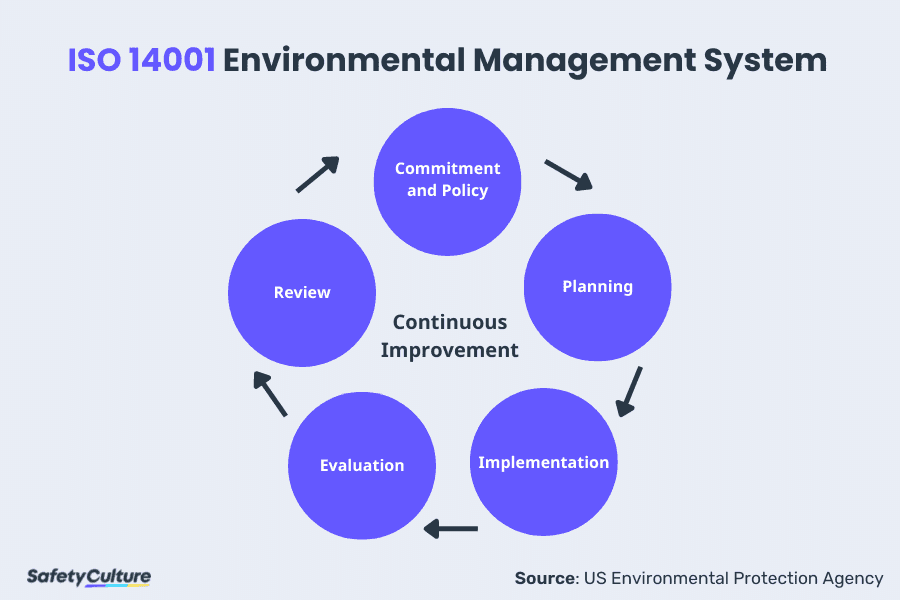What is an Environmental Management System (EMS)?
An Environmental Management System (EMS) is the framework that an organization uses to achieve its environmental goals. An EMS is there to map out the efforts the organization needs to take to meet the goals, how they can accomplish the goals, and how to implement the changes to the organization.
The majority of consumers consider a company’s sustainability efforts before buying a product, which makes sustainability a top goal for various organizations. On top of that, countries are rolling out environmental compliance requirements for organizations to follow. Along with these requirements, many companies also have their own commitments to sustainability that come with a set of environmental goals.
An EMS is not designed to define and state the company’s or enterprise’s environmental goals. Instead, the EMS is there as the foundation where the organization can work towards accomplishing its objectives.
Example
Each company and organization will require a different type of environmental management system. Every EMS is tailored toward the needs and goals of an organization, so no two EMS will look the same.
That said, organizations use quite a few standards and types of EMS in different industries. These include the ISO 14000 Series and the Eco-Management Audit Scheme.
While every EMS is different, they all work toward continuous improvement. A company’s EMS should be designed to help them achieve and surpass their goals.
Types
Environmental management systems differ from organization to organization. Below are some of the most common types of EMS organizations can utilize to create the framework that helps them achieve their environmental goals.
ISO 14001 Standard for EMS
The ISO 14001 standard is designed for organizations to achieve environmental goals. In the basic example below, you can see the key elements of an EMS and how it’s a cycle in which organizations strive to improve their environmental efforts.
This standard is part of the ISO 14000 family, which is a set of different standards that organizations can use to create a comprehensive framework that they can follow to help them reach environmental goals.
Eco-Management and Audit Scheme (EMAS)
The European Commission originally developed EMAS in 1991. This type of EMS allows companies and organizations to manage, assess, and improve their environmental goals and actions. Similar to the ISO 14001 standard, EMAS encourages continuous improvement of the organization’s EMS to help them achieve larger environmental goals.
ISO 14005
ISO 14005 is also under the ISO 1400 family, along with ISO 14004. This system allows organizations to break their environmental goals into smaller, more achievable phases. This allows for more flexibility for companies looking to adjust to different circumstances.
Benefits of an EMS
While an EMS is important for an organization looking to achieve its environmental goals, implementing one is a trade-off.
To start, drafting and finalizing an EMS will take time and effort from employees and may even require organizations to get outside consultants. However, while there is a price to implementing an EMS, the benefits outweigh the costs.
With a proper EMS, organizations can potentially:
- Improve their overall environmental performance
- Reduce the pollutants they release into the environment
- Make it easier to adhere to environmental requirements
- Boost employee morale
- Enter new markets and attract new customers
- Conserve resources
- Reduce costs
- Improve public image
- Promote environmental awareness within the company
Integrate ESG principles into your operations
Drive sustainable growth and create long-term value with our ESG solutions.
Explore nowDeveloping an EMS
Every company may have its own methodology when creating an EMS. However, most EMS start with companies assessing their commitments and environmental policies. They may also consider their country’s environmental laws and requirements to ensure that the EMS covers all bases.
From there, companies usually follow the steps below when crafting their EMS.
Planning
After laying out the goals and environmental policies the EMS aims to help the company achieve, committee members may begin with the planning phase. When planning an EMS, the team needs to determine the environmental aspects of its operations. These are the different things and by-products of their processes that may have an environmental impact.
From there, the team may begin ranking them in importance, making it easier to prioritize the attainable and urgent goals. The result of the planning should be a concrete and quantifiable set of requirements that come from definite objectives.
Implementation
Once there is a definite plan, organizations can begin implementing the EMS. Companies need to employ all the resources possible to ensure that the EMS is being followed and that teams are always finding improvement areas.
During implementation, it’s important to document the processes, keep records, and set up communication lines to keep things running as smoothly as possible.
Assessment
As mentioned earlier, a key aspect of an EMS is finding ways to improve the system and achieve larger goals.
So a major part of the EMS is assessing the areas where the EMS worked, where it didn’t, and how the team can improve things. If the goals weren’t met, the organization needs to take action and start planning different ways of addressing the issues.
Create Your Own EMS Audit Checklist
Eliminate manual tasks and streamline your operations.
Get started for FREEApplying Changes
After determining the issues of the EMS and where it isn’t performing as it should, the next step is applying the different changes. Organizations must take all the appropriate steps to ensure the EMS is implemented properly so that the same problems won’t pop up later.





